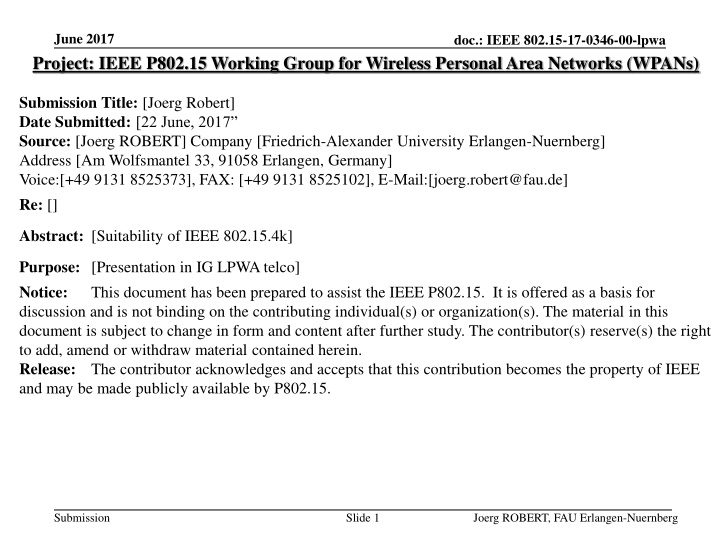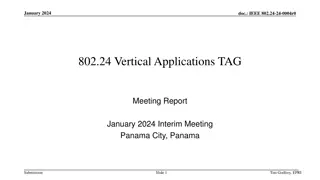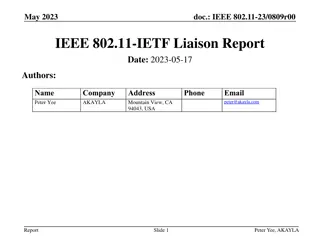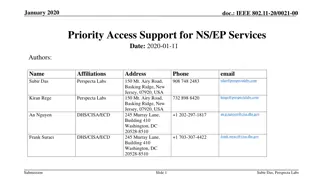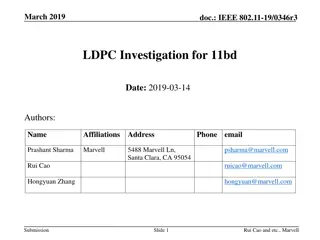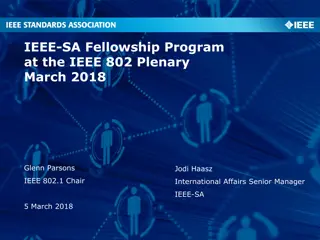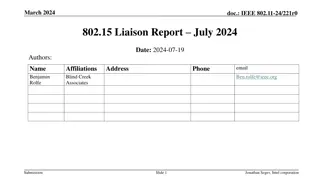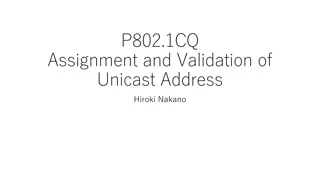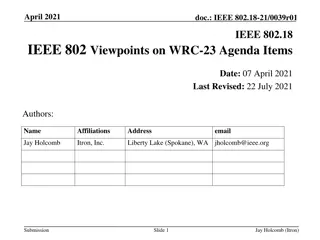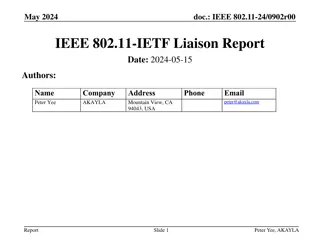Suitability of IEEE 802.15.4k for LPWAN Applications
This document discusses the suitability of IEEE 802.15.4k for Low Power Wide Area Network (LPWAN) applications, focusing on fragmentation, modulation, pros, and cons of the current approach.
Download Presentation

Please find below an Image/Link to download the presentation.
The content on the website is provided AS IS for your information and personal use only. It may not be sold, licensed, or shared on other websites without obtaining consent from the author.If you encounter any issues during the download, it is possible that the publisher has removed the file from their server.
You are allowed to download the files provided on this website for personal or commercial use, subject to the condition that they are used lawfully. All files are the property of their respective owners.
The content on the website is provided AS IS for your information and personal use only. It may not be sold, licensed, or shared on other websites without obtaining consent from the author.
E N D
Presentation Transcript
June 2017 Project: IEEE P802.15 Working Group for Wireless Personal Area Networks (WPANs) doc.: IEEE 802.15-17-0346-00-lpwa Submission Title: [Joerg Robert] Date Submitted: [22 June, 2017 Source: [Joerg ROBERT] Company [Friedrich-Alexander University Erlangen-Nuernberg] Address [Am Wolfsmantel 33, 91058 Erlangen, Germany] Voice:[+49 9131 8525373], FAX: [+49 9131 8525102], E-Mail:[joerg.robert@fau.de] Re: [] Abstract: [Suitability of IEEE 802.15.4k] Purpose: [Presentation in IG LPWA telco] Notice: This document has been prepared to assist the IEEE P802.15. It is offered as a basis for discussion and is not binding on the contributing individual(s) or organization(s). The material in this document is subject to change in form and content after further study. The contributor(s) reserve(s) the right to add, amend or withdraw material contained herein. Release: The contributor acknowledges and accepts that this contribution becomes the property of IEEE and may be made publicly available by P802.15. Submission Slide 1 Joerg ROBERT, FAU Erlangen-Nuernberg
June 2017 doc.: IEEE 802.15-17-0346-00-lpwa Suitability of IEEE 802.15.4k Submission Slide 2 Joerg Robert, FAU Erlangen-Nuernberg
June 2017 doc.: IEEE 802.15-17-0346-00-lpwa Background Pat presented a white paper on the suitability of IEEE 802.15.4 for LPWAN applications (15-17/248r0) (https://mentor.ieee.org/802.15/dcn/17/15-17-0248-00-lpwa-summary- of-ieee-std-802-15-4-lecim.docx) Existing IEEI 802.15.4 technologies already fulfill many requirements of LPWAN Open questions remained on the applied fragmentation approach in order to fulfill the 0.4s FCC requirement Submission Slide 3 Joerg Robert, FAU Erlangen-Nuernberg
June 2017 doc.: IEEE 802.15-17-0346-00-lpwa Fragmentation in 802.15.4k 802.15.4k allows the efficient fragmentation of the MPDU into multiple fragments that are passed to the PHY The PHY then treats every fragment as a separate PSDU The fragmentation approach uses compression techniques to minimize the additional fragmentation overhead Submission Slide 4 Joerg Robert, FAU Erlangen-Nuernberg
June 2017 doc.: IEEE 802.15-17-0346-00-lpwa PSDU PHY Modulation IEEE 802.15.4k FSK PHY Modulation Block Diagram The PHY Modulation treats every PSDU separately Separate FEC encoding, separate sync, ... Reassembly is achieved on MAC layer Submission Slide 5 Joerg Robert, FAU Erlangen-Nuernberg
June 2017 doc.: IEEE 802.15-17-0346-00-lpwa Pros and Cons of the Current Approach Pros: PHY Modulation wrt. other 802.15.4 systems is kept unchanged Simple decoding and re-assembly on the MAC layer Frequency hopping possible to achieve 0.4s FCC limitation Cons: Significant loss wrt. theoretical performance The lowest possible data-rate is limited due to the overhead Additional signaling overhead gets very significant for low data- rates Submission Slide 6 Joerg Robert, FAU Erlangen-Nuernberg
June 2017 doc.: IEEE 802.15-17-0346-00-lpwa Loss wrt. Theoretical Performance Loss of performance in case of limited payload block sizes k of the code Short code words lead to reduces performance denotes the spectral efficiency Vertical lines are the Shannon Capacity Submission Slide 7 Joerg Robert, FAU Erlangen-Nuernberg
June 2017 doc.: IEEE 802.15-17-0346-00-lpwa Lowest Possible Rate ( I / IV ) Format of the 802.15.4k FSK PHY Each fragment has at least 5 bytes overhead Submission Slide 8 Joerg Robert, FAU Erlangen-Nuernberg
June 2017 doc.: IEEE 802.15-17-0346-00-lpwa Lowest Possible Rate ( II / IV ) The fragment format adds 4 or 6 additional bytes overhead Each fragment contains at least 9 bytes of overhead Submission Slide 9 Joerg Robert, FAU Erlangen-Nuernberg
June 2017 doc.: IEEE 802.15-17-0346-00-lpwa Lowest Possible Rate ( III / IV ) We now assume that each fragment contains only 1 byte payload data Fragment size of 10 bytes = 80 bits Lowest bit-rate without coding: 200 bit/s with 90% overhead We now assume that each fragment contains 9 byte payload data Fragment size of 18 bytes = 144 bits Lowest bit-rate without coding: 360bit/s with 50% overhead Submission Slide 10 Joerg Robert, FAU Erlangen-Nuernberg
June 2017 doc.: IEEE 802.15-17-0346-00-lpwa Lowest Possible Rate ( IV / IV ) Use of FEC with code-rate would approx. require doubling the symbol rate ~500bit/s (lowest rate supported by 802.15.4k FSK PHY) Submission Slide 11 Joerg Robert, FAU Erlangen-Nuernberg
June 2017 doc.: IEEE 802.15-17-0346-00-lpwa Minimum RX-Level Eb/N0=20dB without coding (PER ~1%) Eb/N0=10dB with coding (PER ~1%) w/ coding Min. RX level in the order of -135dB with coding and -130dBm with coding Definition of LPWAN < -140dBm w/o coding Submission Slide 12 Joerg Robert, FAU Erlangen-Nuernberg
June 2017 doc.: IEEE 802.15-17-0346-00-lpwa Loss due to Overhead Additional overhead reduces payload bit- rate (50% assumption) 25...30dB loss wrt. theoretical limits 316 ... 1000 times the energy of a perfect system battery lifetime w/ coding w/o coding Worse than competitors (15-16-0486r0) Submission Slide 13 Joerg Robert, FAU Erlangen-Nuernberg
June 2017 doc.: IEEE 802.15-17-0346-00-lpwa Conclusions Fragmentation is one mean in 802.15.4k to reduce the transmit duration to meet FCC regulation However, the employed MAC fragmentation shows significant gaps wrt. the theoretical limits Using 802.15.4 with PHY fragmentation could significantly improve the results >20 dB more sensitivity More than 100 time less energy Submission Slide 14 Joerg Robert, FAU Erlangen-Nuernberg
June 2017 doc.: IEEE 802.15-17-0346-00-lpwa Thank You for Your Interest! Submission Slide 15 Joerg Robert, FAU Erlangen-Nuernberg
